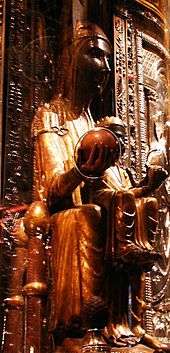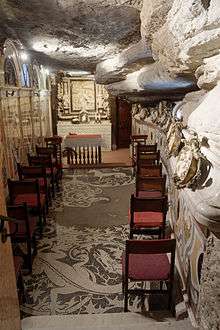Spiritual Exercises of Ignatius of Loyola

1548, First Edition by Antonio Bladio (Rome) (158x108 mm)
The Spiritual Exercises of Ignatius of Loyola (Latin original: Exercitia spiritualia) (composed 1522–1524) are a set of Christian meditations, prayers and mental exercises, written by Saint Ignatius of Loyola, a 16th-century Spanish priest, theologian, and founder of the Society of Jesus (Jesuits). Divided into four thematic "weeks" of variable length, they are designed to be carried out over a period of 28 to 30 days.[1] They were composed with the intention of helping participants in religious retreats to discern the will of God in their lives, leading to a personal commitment to follow Jesus whatever the cost. Although their underlying theology is Catholic, the exercises can also be undertaken by non-Catholics.
Editions
A review of the publication history of the Spiritual Exercises can be found on the website of Loyola Press.[2]
The first printed edition of the "Spiritual Exercises" was published in Latin in 1548, after being given papal approval by Paul III.[3] However, Ignatius's manuscripts were in Spanish, so this first edition was in fact a translation, although it was made during Ignatius's lifetime and with his approval.
Many subsequent editions in Latin and in various other languages were printed over the centuries with widely differing texts.
Archival work on the authentic text of the Spiritual Exercises was undertaken at the initiative of the 19th century Jesuit Superior General Jan Roothaan, who himself published a translation and notes from the original manuscripts of St. Ignatius. The culmination of this work was a "critical edition" of the Exercises published by the Jesuit order in 1919, in the "Monumenta Historica Societatis Jesu" series.[4]
An authoritative Spanish-Latin text, based on the critical edition, was published in Turin by Marietti, in 1928. This was edited by the editor of the critical edition, and included convenient marginal numbers for every section.
An English translation by Louis J. Puhl, SJ, published in 1951, has been widely used by Jesuits, spiritual directors, retreat leaders, and others in the English-speaking world. Puhl translated directly from studies based on the original manuscripts.[5]
Background

After recovering from a leg wound incurred during the Siege of Pamplona in 1521, Ignatius made a retreat with the Benedictine monks of the abbey of Montserrat, a mountain town in northern Spain. The monks introduced him to the spiritual exercises of Garcia de Cisneros, which were based in large part on the teachings of the Brothers of the Common Life, the promoters of the "devotio moderna". From Montserrat, he went on towards Barcelona but took a detour through the town of Manresa, where he eventually remained for several months, continuing his convalescence at a local hospital. During this time he discovered The Imitation of Christ of Thomas à Kempis, the crown jewel of the "devotio moderna".[6] He also spent much of his time praying in a cave nearby, where he practiced rigorous asceticism. During this time Ignatius experienced a series of visions, and formulated the fundamentals of his Spiritual Exercises. He would later refine and complete the Exercises when he was a student in Paris.

The Spiritual Exercises of Saint Ignatius form the cornerstone of Ignatian Spirituality: a way of understanding and living the human relationship with God in the world as practiced by members of the Society of Jesus (Jesuits). Although he originally designed them to take place in the setting of a secluded retreat, during which those undergoing the exercises would be focused on nothing other than the Exercises, Ignatius also provided a model in his introductory notes for completing the Exercises over a longer period without the need of seclusion. The Exercises were designed to be carried out while under the guidance of a spiritual director, but they were never meant only for monks or priests: Ignatius gave the Exercises for 15 years before he was ordained, and years before the Society of Jesus was even founded. When lay people undergo the Exercises, however, this is often under the guidance of a spiritual director who is himself a Jesuit.
Ignatius considered the examen, or spiritual self-review, to be the most important way to continue to live out the experience of the Exercises after their completion.
After the Society of Jesus was formed, the Exercises became the central component of the training program. They usually take place during the first year of a two-year novitiate.
Spiritual viewpoint
Ignatius identified the various motives that lead a person to choose one course of action over another as "spirits".[7] The main aim of the Exercises is the development of discernment (discretio), the ability to discern between good and evil spirits. A good "spirit" can bring love, joy, peace, but also desolation, to bring one to re-examine one's life. An evil spirit usually brings confusion, and doubt, but may also prompt contentment to discourage change. The human soul is continually drawn in two directions: towards goodness but at the same time towards sinfulness.
According to the theologian Hans Urs Von Balthasar, "choice" is the center of the Exercises, and they are directed to choosing God's choice, i.e., ultimately to a self-abandonment to God.[8] The Exercises “have as their purpose the conquest of self and the regulation of one’s life in such a way that no decision is made under the influence of any inordinate attachment.”
"Discernment" is at the heart of Ignatian thought. Through the process of discernment, the believer is led towards a direct connection between his thought and action, and the Grace of God. As such discernment can be considered a movement toward mystical union with God, and it emphasizes the mystical experience of the believer. This aspect of the Spiritual Exercises would become typical of the mystical trend in Catholic thought which flourished during the time of the counter-reformation (e.g., with Theresa of Avila, Francis de Sales, and Pierre de Bérulle). However, while discernment can be understood as a mystical path, it can also more prosaically be understood as a method of subjective ethical thought. The Exercises emphasize the role of one's own mental faculties in deciding what is right and wrong.
Part of a series on the |
| Society of Jesus |
|---|
 Christogram of the Jesuits. |
| History |
| Hierarchy |
| Spirituality |
| Notable Jesuits |
|
|
Typical methodology and structure
Within the Exercises, daily instructions include various meditations and contemplations on the nature of the world, of human psychology as Ignatius understood it, and of man's relationship to God through Jesus Christ. The Exercises are divided into four "weeks" of varying lengths with four major themes: sin, the life of Jesus, the Passion of Jesus, and the Resurrection of Jesus. The "weeks" represent stages in a process of wholehearted commitment to the service of God. During each day of the Exercises, a typical retreatant prays with a particular exercise, as assigned by the director, reviews each prayer, and, following four or five periods of prayer, reports back to the spiritual director of the retreat who helps them to understand what these experiences of prayer might mean to the retreatant. The goal of the Exercises is to reflect upon their experiences and to understand how these same experiences might apply to the retreatant's life.
Modern applications
The Spiritual Exercises of Ignatius of Loyola are still considered among the important works of spiritual literature.[8] They remain an integral part of the Novitiate training of the Jesuits, and many local Jesuit programs offer retreats for the general public based on the Exercises.
Beginning in the 1980s, there has been a growing interest in the Spiritual Exercises from people from other Christian traditions. "The Spiritual Exercises" are also popular among lay people[9] both in the Catholic Church and other denominations, and lay organizations like the Christian life community place the Exercises at the center of their spirituality. There are adaptations that are specific to Protestants which emphasize the exercises as a school of contemplative prayer. The Exercises usually are undertaken with the help of a trained spiritual guide.
The traditional form of the Exercises is a retreat of about 30 days in silence and solitude.[9] Participants in the full Exercises may spend up to 5 hours a day in prayer. In the original form each retreatant has a guide to help lead him or her through the meditations of the Exercises. The Exercises done in this full-time way offer what is probably the most intensive spiritual experience. Most commonly such a retreat is undertaken at a retreat centre that specializes in the Exercises.
The most common way of going through the Exercises now is a "retreat in daily life", which involves a months' long program of daily prayer and meetings with a spiritual director.[9] Also called the "19th annotation exercises" based on a remark of St. Ignatius in the 19th footnote in his book, does not require an extended stay in a retreat house and the learned methods of discernment can be tried out on day-to-day experiences over time.
As well as the full Spiritual Exercises done residentially over 30 days, there are centres offering the full 30 days in two or three sections over a two-year period. Most centers offer shorter retreats with some of the elements of the Spiritual Exercises. Retreats have been developed for specific groups of people, such as those who are married or engaged. Self-guided forms of the Exercises are also available, including online programs.
See also
- Christian meditation
- Ignatius of Loyola
- Ignatian spirituality
- Society of Jesus
- Oblates of the Virgin Mary
Notes
- ↑ Counsell, Michael. 2000 Years of Prayer, 2004, ISBN 1-85311-623-8 p. 203
- ↑ St. Ignatius Loyola, The Spiritual Exercises, accessed 7 November 2016.
- ↑ In the brief Pastoralis officii of 31 July 1548
- ↑ Monumenta Historica Societatis Jesu, Monumenta Ignatiana, Series Secunda: Exercitia Spiritualia. Madrid, 1919.
- ↑ Available online here.
- ↑ De La Boullaye, Pinard. Ignatian Spirituality.
- ↑ Tetlow, Joseph A., "Discernment in a Nutshell", Making Choices in Christ, Loyola Press
- 1 2 Löser S.J., Werner. "The Ignatian Exercises in the Work of Hans Urs von Balthasar", Hans Urs Von Balthasar: His Life and Work, (David L. Schindler, ed.) Ignatius Press, 1991 ISBN 9780898703788
- 1 2 3 "The Spiritual Exercises" Ignatian Spirituality, Loyola Press
References
- Ignatius of Loyola, Spiritual Exercises, London, 2012. limovia.net ISBN 978-1-78336-012-3
- David L. Fleming, S.J. The Spiritual Exercises of St. Ignatius, A Literal Translation and A Contemporary Reading. The Institute of Jesuit Sources, St. Louis, 1978. ISBN 0-912422-31-9
- Timothy M. Gallagher, The Discernment of Spirits: An Ignatian Guide for Everyday Life. Crossroad (2005).
- George E. Ganss, S.J. The Spiritual Exercises of Saint Ignatius: A Translation and Commentary. Chicago: Loyola Press, 1992. ISBN 0-8294-0728-6.
- Anthony Mottola, Spiritual Exercises of Saint Ignatius. Image (1964), ISBN 0-385-02436-3.
- Joseph A. Tetlow, The Spiritual Exercises of Ignatius Loyola. Crossroad (2009).
- "Spiritual Exercises of Saint Ignatius". Catholic Encyclopedia, New Advent.
External links
- Online text
- The full text of Spiritual Exercises in several formats – Archive.org
- "Spiritual Exercises of St. Ignatius of Loyola". Christian Classics Ethereal Library.
- Others
- Finding Our way Together - Spiritual Exercises for Companions
- About the Spiritual Exercises
- The Examen Prayer (video)
- The Examen
- The Spiritual Exercises of St. Ignatius Loyola: Renewal and Dynamics – Videos of expert speakers, including Howard Gray, S.J., and John O'Malley, S.J., on the history and renewal of the Spiritual Exercises since Vatican II.